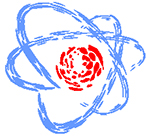Speaker
Ms
Veronika Pastykova
(Faculty of Nuclear Sciences and Physical Engineering, CTU Prague)
Description
Objectives: The main purpose of the study is to evaluate the radiobiological effect of the dose rate changes in Leksell Gamma Knife (LGK) clinical conditions. In principle there are two reasons why dose rate on LGK is reduced during patient irradiation: 1) Co-60 sources decay with half-life of 5.26 years and 2) using multiple isocenters and conformal treatment plans (e.g. with blocked beams). This pilot study is an experimental work performed in vitro with meduloblastoma DAOY cells.
Methods and materials: A number of repeated experiments were performed with meduloblastoma DAOY cells irradiated on LGK Perfexion by various dose rates (0.35 – 3.31 Gy/min). The irradiation was performed in a spherical Elekta ABS plastic phantom with the special insert for the Eppendorf tube containing cells. Leksell GammaPlan treatment planning software was used to plan cell irradiation. The control of the different dose rates of LGK was achieved by two ways: 1) reloading of the Co-60 sources in our hospital after performing the first experimental campaigns and 2) sector blocking of the LGK collimator (0, 4 or 6 of 8 sectors of LGK were blocked to achieve full, half or quarter dose rate). To ensure homogenous irradiation of the cells 16 mm collimator was used. Plating efficiency and surviving fraction was determined for each experimental cell sample. Nine different doses in the range 0 – 6 Gy were used to have enough experimental points to obtain surviving curve. Linear quadratic model was used to fit experimental data. Surviving curves for different dose rates were plotted and compared, as well as the α/β parameters.
Results: This is an initial pilot study with very preliminary data. However, based on so far obtained data it could be observed higher cell survival for dose rates lower than 0.40 Gy/min compared to higher dose rates over 0.75 Gy/min. Currently, experiments continue with dose rates between 1.60 – 3.31 Gy/min taking into account more biological endpoints of the irradiation.
Conclusion: Preliminary data from this study do show different cell survival for studied meduloblastoma DAOY cells based on a dose rate that was used for an irradiation. Higher survival is observed for a lower dose rate. However, more experimental work is needed to provide data beneficial for clinical practices of gamma knife.
This study was supported by the Ministry of Health, Czech Republic - conceptual development of research organization (Nemocnice Na Homolce - NNH, project n. 00024883).
Primary author
Ms
Veronika Pastykova
(Faculty of Nuclear Sciences and Physical Engineering, CTU Prague)
Co-authors
Ms
Jana Vachelova
(Nuclear Physics Institute of the CAS, Dep. of Radiation Dosimetry, Prague, Czech Republic)
Mr
Josef Novotny Jr.
(Na Homolce Hospital, Dep. of Medical Physics, Prague, Czech Republic)
Mrs
Marie Davidkova
(Nuclear Physics Institute of the CAS, Dep. of Radiation Dosimetry, Prague, Czech Republic)
Ms
Marketa Hurychova
(Czech Technical University in Prague, Faculty of Nuclear Sciences and Physical Engineering, Dept. of Dosimetry and Application of Ionizing Radiation, Prague, Czech Republic)
Mr
Miroslav David
(Czech Technical University in Prague, Faculty of Nuclear Sciences and Physical Engineering, Dept. of Dosimetry and Application of Ionizing Radiation, Prague, Czech Republic)
Mr
Roman Liscak
(Na Homolce Hospital, Dep. of Stereotactic and Radiation Neurosurgery, Prague, Czech Republic)

